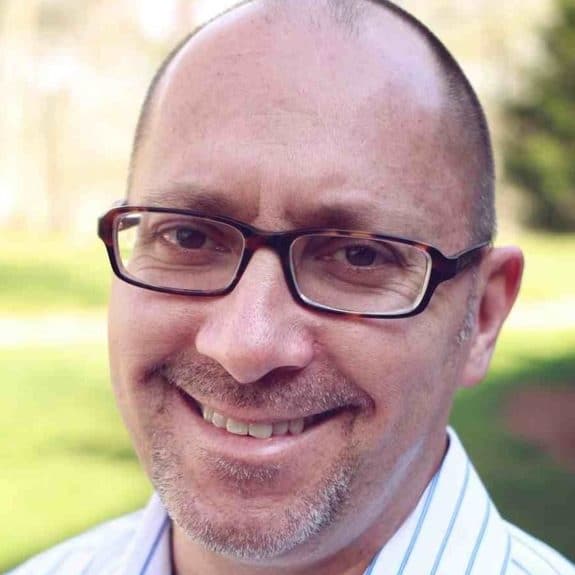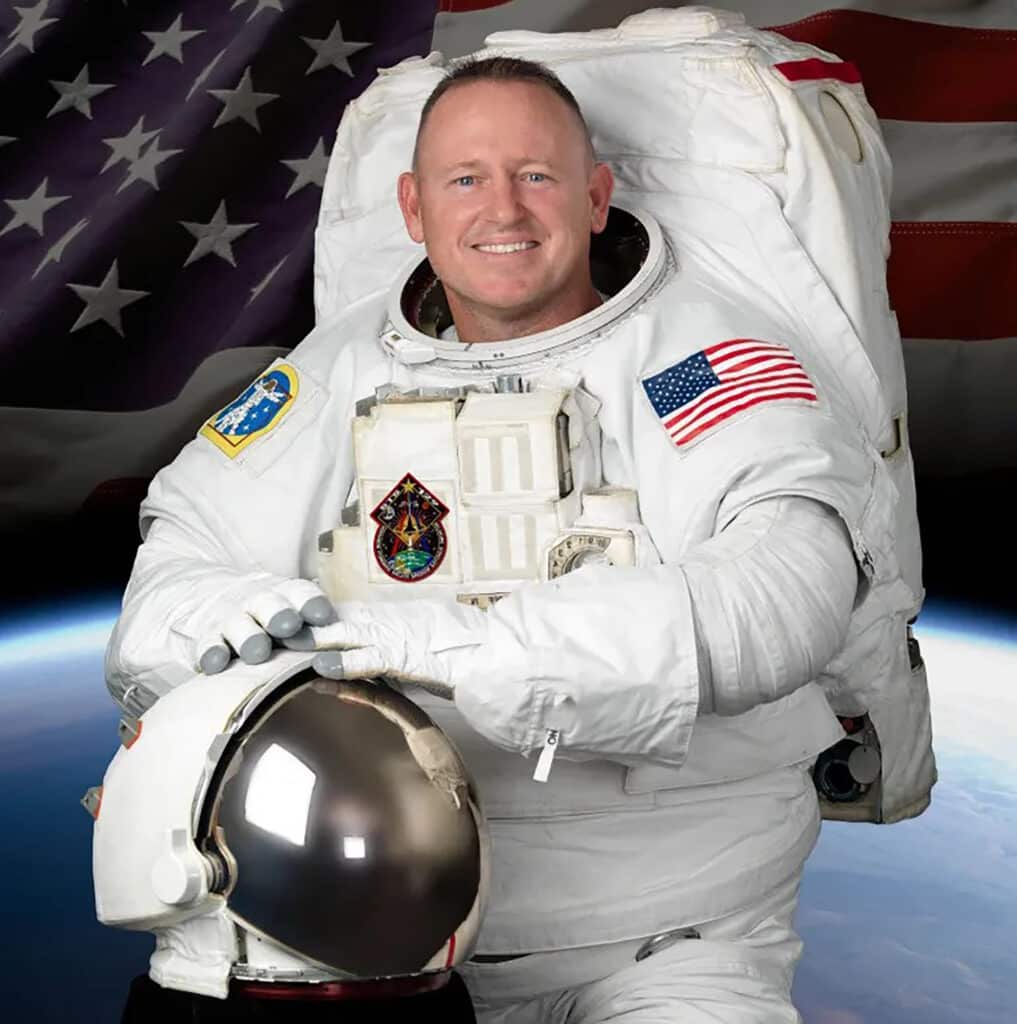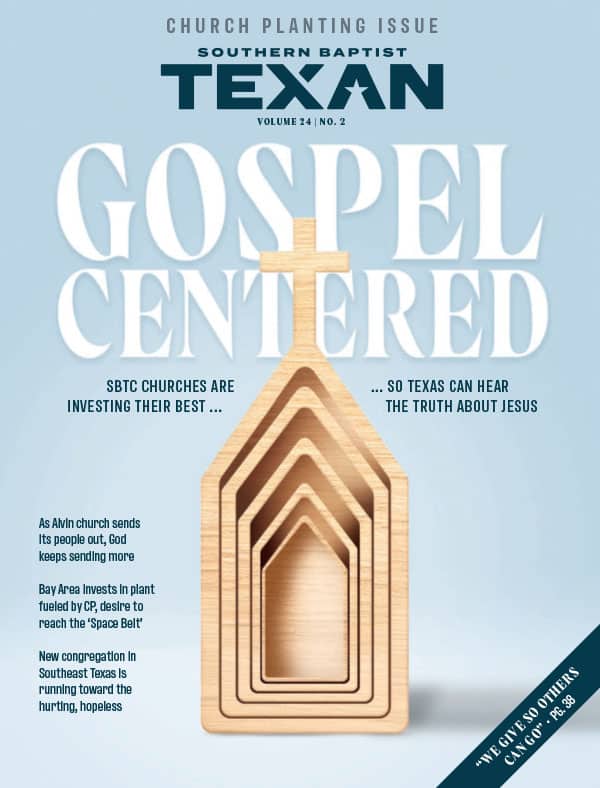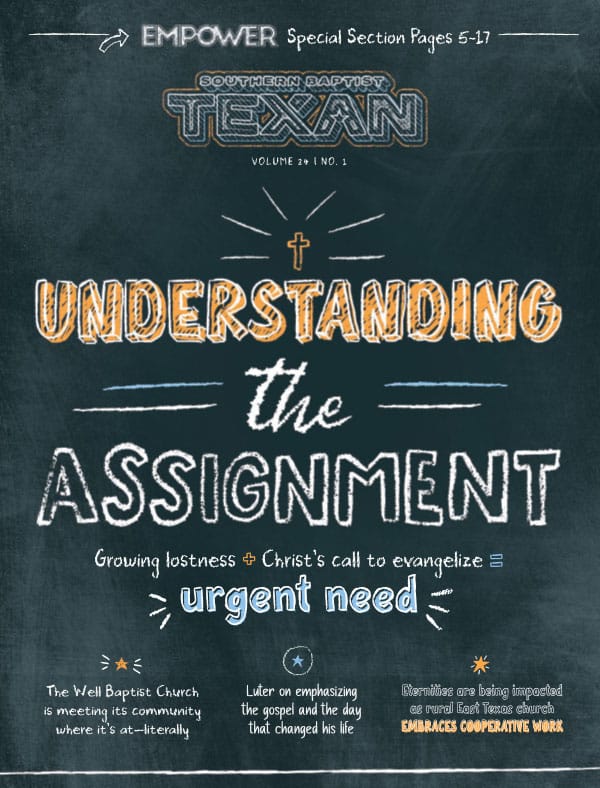|
FORT WORTH–Steven M. Ortiz grew up in east Los Angeles, attending a Southern Baptist church with his then newly converted father and listening to sermons from a pastor who was always citing the background of the biblical text. The historical and cultural background of the Bible “My personality is the type that I want to touch and taste it,” said Ortiz, reflecting on his journey from a curious kid to a Ph.D. archaeologist who has worked with some of the foremost scholars in his field. The day the TEXAN interviewed him in his office at Southwestern Baptist Theological Seminary in Fort Worth, his adrenaline was just beginning to subside from the week before, when the seminary’s I. Ruth Martin Collection of archaeological artifacts, dating back to the Iron Age (1,000-586 B.C.), was “rediscovered” after being stumbled upon deep in the bowels of the climate-controlled library archives. It seems the collection was inconspicuously marked, boxed and stored amid aging church music documents on the bottom of a shelf. A week-and-a-half later, Ortiz was lecturing a handful of students in the newly minted seminar room that now houses the Martin collection. Many of the more than 100 pieces of pottery, including cuneiform tablet writings, jars, oil lamps, plus ancient coins were already displayed in glass cases. The recovery of the artifacts, which join other artifacts in the Charles C. Tandy Archaeological Museum at Southwestern, gives students a tangible sense of biblical history, he said. “For the program to have a dedicated seminar room for the students to get hands-on experience is very important,” Ortiz said. Ortiz joined the Southwestern staff this fall as associate professor of archaeology and biblical backgrounds and director of the Tandy Museum, coming from New Orleans Baptist Theological Seminary. After Hurricane Katrina sent the Ortizes to Grapevine to be near family, Ortiz found Eventually, that relationship developed into an opportunity to revive the archaeology program at Southwestern, which discontinued its program in the early 1990s. This fall Ortiz has been busy teaching several courses and designing a curriculum to propose to the school’s trustees at their spring meeting for the master of arts program in archaeology and biblical studies. Eventually, the goal is to offer a doctoral degree in biblical archaeology. Seminary President Paige Patterson told trustees at their October meeting: “Literally, there are only a handful of schools in this country that even offer a doctor’s degree in archaeology now. For us to be able to step into that vacuum at this time is absolutely beyond any thought that I would have had to hope for. … It’s terribly important as an accompaniment to Old Testament and New Testament studies.” The revived M.A. program, the first step Ortiz said, will be one of only two among SBC seminaries–the other is at Midwestern Seminary–and one of the few programs at evangelical Christian schools where scholarship will include archaeological digs and exposure to some of the world’s leading scholars. Ortiz said most programs involve studying about archaeology; Southwestern’s program will be unusual among evangelical schools in that it will expose students to primary archaeological research as well as biblical backgrounds. Ortiz said if all goes as planned, master’s-level students may begin the program next fall. In its former work in the 1980s under the leadership of George Kelm, now retired and living in San Antonio, the seminary participated in a dig, known as a “tel,” at Timnah, Israel; some of the artifacts from that dig are stored in the Tandy Museum. GEZER: ANCIENT FORTRESS Gezer is on a strategic path that led from the lower elevations through the mountains to Jerusalem, Ortiz said. By the late Bronze Age (1,500-1,200 B.C.), “Every time an Egyptian king marched through the Holy Land, they had to conquer Gezer [to get to Jerusalem],” Ortiz said. Scripture tells of David driving the Philistines as far as Gezer, marking it a boundary point between Israel and Philistine lands, Ortiz said. Gezer is referred to in 1 Kings 9:15-17 as one of Solomon’s fortified cities. If armies were to get to Jerusalem from the east, they would pass near Gezer, he said. The passage tells that Pharaoh captured Gezer, killed the Canaanite inhabitants and then gave it as a dowry to Solomon for his daughter, who was one of Solomon’s wives. This summer Gezer was re-excavated for the first time in 30 years by a joint archaeological expedition, led in part by Ortiz and Wolff. It will continue in 2007 with consortium members that include Southwestern, Lancaster Bible College, Midwestern Baptist Theological Seminary, the Marian Eakins Archaeological Museum, Lycoming College and Grace Seminary. In fact, Southwestern will co-sponsor the dig work at Tel Gezer, a shift that comes in conjunction with Ortiz’ move to Southwestern. “The Tel Gezer excavations have the potential to be one of the few American excavation projects in Israel that is training the next generation of biblical archaeologists,” Ortiz said. Regarding ancient Israel, Ortiz told the school’s trustees during their fall meeting that critical scholars have contended that literacy was very low in ancient Israel and that the Old Testament canon is a late document, perhaps revised and compiled after the Babylonian exile. But due to an artifact uncovered at Gezer, “In the 10th century we already have a little schoolboy practicing a little poem, sort of like a farmer’s almanac,” Ortiz told the trustees. “It’s the agricultural cycle of the year. But it’s written in a hand that is not familiar with the language, somebody who is learning the text. “One of the things that Gezer tells us is that somebody in the 10th century was already practicing how to read and write.” ARCHAEOLOGY AS APOLOGETIC “Because of archaeological research you can no longer deny the historicity of the Bible,” he said. “What you do is you change the historicity of the Bible. And so you’d find other Gospels. You just change it a little—Jesus being married to Mary Magdalene, etcetera, etcetera. In Old Testament [studies] there are similar trends there. You don’t deny the historicity of David and Solomon any more, you just change it a little—David and Solomon weren’t really ancient kings of Israel; they were small tribal chieftains. Or, we have all the dating wrong,” Ortiz explained, giving examples of how revisionists attempt to dismiss the biblical account. “And this is where my work comes in. This is where it’s important. As you can see, David is a hot topic. Can a history of Israel be written? ‘The Mythic Past,’” Ortiz said, reading a book title. “These are textbooks used in major universities. ‘The Invention of Ancient Israel,’ ‘The Creation of History in Ancient Israel.’ If you go down the street to SMU, go down to the University of Texas, Texas A&M, these are the textbooks that are used in a basic Bible course. “And so you must as pastors, as ministers, when you send out your college students and they come back, they’re asking you the question, ‘What do I do? Is the Bible true? I’ve been challenged in my Bible history course.’ And that’s one of the issues God has called me to in terms of apologetics and in terms of my research goals. The accounts of David: Are they historical or are they mythological? And this is the question that’s presented in most classes. “The solution, naturally, is archaeological research, going and actually having evangelicals involved in archaeology. As you know, most evangelicals have abandoned archaeology for many reasons. One, it’s difficult. It’s hard to stay married. You leave your wife for two months. You get dirty. You deal with pottery. It’s not interesting. You get boring lectures in class. So, most people avoid archaeology.” THE ARCHAEOLOGY BUG “I fell in love with archaeology,” he said. “I fell in love with the land. I finished my undergraduate degree, and went to Israel to work on my masters.” While there he was able to study under some world-renown archaeologists and earn a master’s degree in biblical history. From there, he headed to the University of Arizona, where he earned a master’s and Ph.D. in Near Eastern archaeology under noted scholar William Dever. A committed Baptist evangelical in a field of many skeptics, Ortiz was able to use his unusual background when an offer to teach came from New Orleans Seminary. “God brought both passions (archaeology and the Christian faith) together at New Orleans,” Ortiz said. While there, Ortiz taught and directed the Center for Archaeological Research and brought the program into some level of prominence, bringing to campus speakers such as Israeli archaeologist Gabriel Barkay. While excavating a burial tomb near Jerusalem in 1979, Barkay uncovered the oldest known copy of Old Testament scripture. The priestly blessing, recorded in Numbers 6:24-26, was discovered on two small silver scrolls dated to the 7th century B.C. New Orleans Seminary’s archaeology program frequently began to draw attention from the city’s newspaper, the Times-Picayune, mostly because of a reporter who was intrigued by archaeology,“ Ortiz said. In 2004, Biblical Archaeology Review called Ortiz a “prominent evangelical scholar” in the field. At a Houston luncheon in 1994 hosted by the American Jewish Federation and the Anti-Defamation League that featured Southern Baptist ethicist Richard Land, a Jewish host, in introducing Land as an alumnus of New Orleans Seminary, lauded the school for what he described as it fine work in biblical archaeology. “That [Gabriel Barkay] lecture catapulted the program,” Ortiz recalled. Patterson told the TEXAN in August: “The appointment of Dr. Ortiz and establishment of an Institute of Biblical Archaeology will make Southwestern Seminary one of the leading research centers of biblical archaeology.” In addition to archaeology students, ministerial students should have a grasp of biblical archaeology, Ortiz said. “It just elevates your preaching, because you’re putting it in the context of its revelation.” Ortiz said donors such as I. Ruth Martin, a Southwestern alumnus and longtime professor at Pembroke State College in North Carolina who died in 1989, are crucial to building a top-notch biblical archaeology program, as are Christian philanthropists who can endow the school, scholarship students for overseas work or fund entire projects. “I hope we will be the next training center for biblical archaeology, at least in the SBC and in the evangelical world, and to be a major player in our field of research and in training students. Part of my commitment to Dr. Patterson is to revitalize the institute for archaeology, and he wants us to train the next generation of professors for our seminaries.” |














